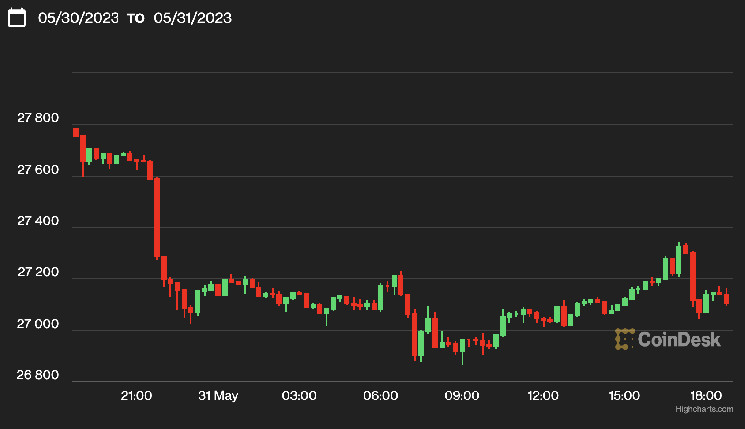Good morning. Here’s what’s happening:Prices: Bitcoin settled above $27.1K after Cleveland's Federal Reserve Bank president spooked investors with hawkish comments and China reported dispiriting manufacturing data.Insights: Before House members approved a bill to raise the debt ceiling, bitcoin whales reduced their holdings and sent assets to exchange.PricesBitcoin Sinks Early, Then Holds Above $27.1K
Hawkish comments by Cleveland’s Federal Reserve Bank president, the increasing likelihood of at least one more interest rate hike by the U.S. central bank and dispiriting Chinese manufacturing data kept crypto investors off-balance on Wednesday.
Bitcoin, the largest cryptocurrency by market capitalization, was trading near $27,100, down more than 2.2% over the previous 24 hours, after spending much of the previous four days comfortably above $27,500. BTC finished May (UTC) with its first losing month of 2023 after soaring by more than 60% over the first four months.
“Bitcoin encountered selling pressure in response to comments made by a prominent Federal Reserve official, indicating a lack of compelling reasons to pause liquidity tightening measures,” Mikkel Morch, chairman and non-executive director at crypto investment fund ARK36, said. “These remarks have had a disruptive impact on various risk assets, including cryptocurrencies.
Morch added: “Simultaneously, the release of discouraging manufacturing data from China has added to the bearish sentiment surrounding bitcoin and other risk assets.”
In an interview with the Financial Times published Wednesday, Fed Cleveland bank President Loretta Mester said that she did not see any reason to cease the Fed’s nearly year-long streak of rate increases, although she was open to changing her mind if the current hot employment market, a characteristic of high inflation periods, and prices cool. “We may have to go further,” she told the Times. “At this point, I don’t really necessarily see a compelling reason that we wouldn’t want to take another small step to counter some of that really embedded, stubborn inflationary pressure.”
Crypto markets have struggled in recent weeks amid uncertainty about the U.S. government’s ability to extend the debt limit and meet its financial obligations, and inflationary concerns. House lawmakers finally passed the bill late Wednesday via a bipartisan effort that overcame strong opposition from far-right Republicans. Meanwhile, the anticipated rebound of the Chinese economy slowed at least temporarily as the official manufacturing purchasing managers index declined to 48.8 in May from 49.2 in April, according to the country’s National Bureau of Statistics said
Ether was recently changing hands at about $1,875, off 1.4% from Tuesday, same time. Other major cryptos spent much of Wednesday in the red with AVAX, the token of the Avalanche base-layer network, and UNI, the native cryptocurrency of the Uniswap decentralized exchange, both recently off more than 2%. The CoinDesk Market Index, a measure of crypto markets performance, was recently down over 2.1%.
Equity markets sank with the tech-focused Nasdaq and S&P 500 both closing down 0.6% as investors recoiled following a strong Job Openings and Labor Turnover (JOLTS) report showed openings increasing to 10.1 million instead of an expected 9.3 million in April, and breaking a three-month streak of declines that had offered hope for monetary policy observers hoping for a dovish turn.
In a Telegram message to CoinDesk, Strahinja Savic, head of data & analytics at crypto-focused, institutional capital markets and advisory platform FRNT Financial, noted that stocks and cryptos had fallen together instead of diverging as they have over the past couple of months. “Today crypto dips with risk assets, tomorrow it may not,” Savic wrote. “What we can say is that the technical range has been clearly set between a downside range of $25K to $26K, and a breakout would occur decisively above $31K. Most other activities are likely noise.”
Have bitcoin and ether bottomed out? Dave Weisberger, the CEO of CoinRoutes, which provides algorithmic trading strategies in the crypto space, noted to CoinDesk TV that bitcoin holding is at an all-time high while BTC to be sold on exchanges and volume on exchanges are at low levels.
Weisberger said the trends tell you “that speculators are moving into pricing and moving out but the long-term buyers seem happy to buy in this below $27K range and cushion in any downdraft. So it feels like we’re in the bottom of a trading range.”
Biggest Gainers
| Asset | Ticker | Returns | DACS Sector | ||||||||||||||||
|---|---|---|---|---|---|---|---|---|---|---|---|---|---|---|---|---|---|---|---|
| Stellar | XLM | +1.7% | Smart Contract Platform
Biggest Losers
|
InsightsA Whale Risk Reduction Strategy Ahead of Debt Deal
On-chain data shows that large holders of bitcoin reduced their bitcoin holdings in the days leading up to the debt deal. Additional data shows an increase in BTC sent to centralized exchanges. What happens next should be monitored closely as an indication of overall sentiment.
The supply of bitcoin held by addresses with balances exceeding 100K BTC declined from 663,306 to 543,958 on May 22, right ahead of the debt deal. A key question is whether the reduction was tied to short-term fiscal concerns, or longer term questions about BTC prices.
While the number of addresses holding more than 100K BTC is small, the activity of whales can sometimes create cascading effects if they exit their positions en masse. The number of addresses with 1,000 BTC or more sending bitcoin to exchanges has increased as well, showing that smaller whales may also be unloading risk.
What happens next is most important. An increase in bitcoin supply for large holders following the debt deal will signal their renewal of bullish sentiment. A continued decline would imply that they have larger concerns.
 coindesk.com
coindesk.com
